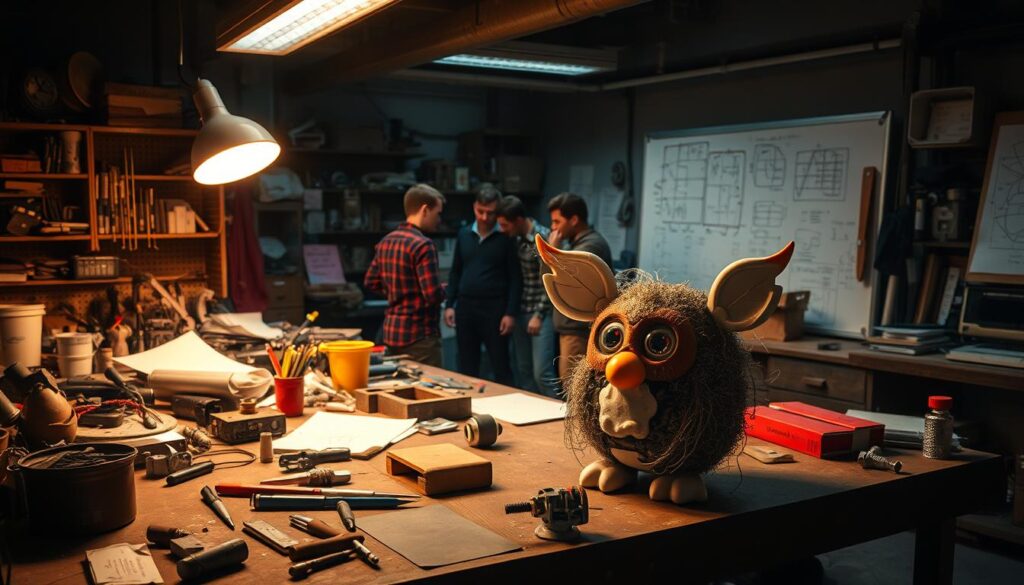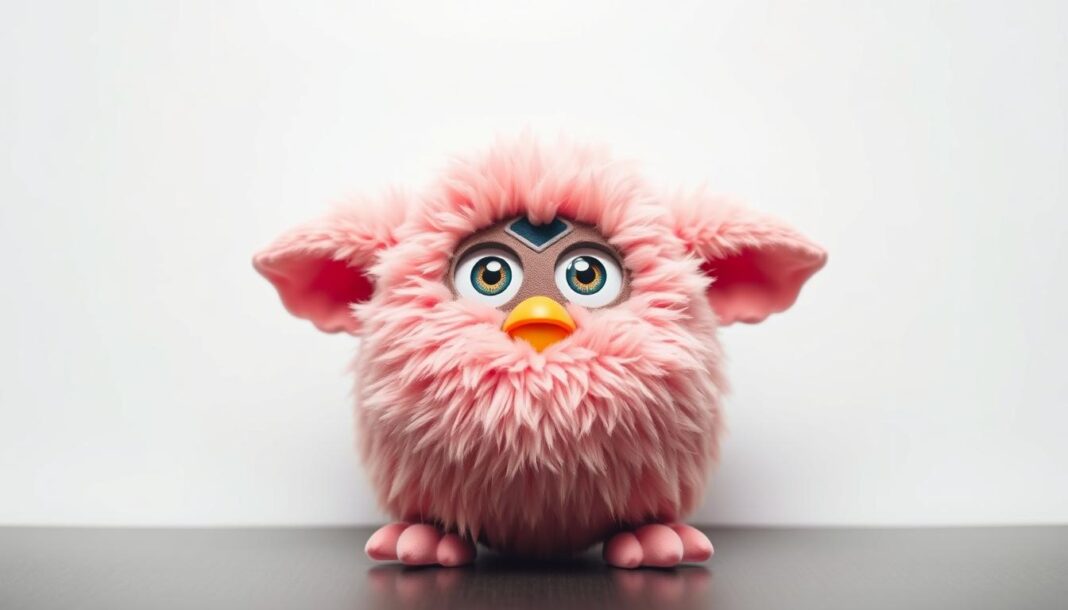The original Furby, a small, electronic robotic creature, captured the hearts of many during the late 1990s. Released by Tiger Electronics, this interactive toy became a cultural phenomenon, selling over 40 million units in just three years.
As we explore the history of this beloved toy, we uncover the fascinating story behind its creation and release. For more insights into the world of Furby, visit our detailed explanation on the original electronic companion. The Furby’s impact on the toy industry was significant, paving the way for future innovations in interactive technology.
Let’s take a closer look at the release of the original Furby and its journey to becoming a nostalgic icon.
The Birth of a Cultural Icon
The Furby phenomenon began to take shape in the late 1990s, marking the birth of a cultural icon. This was a time when interactive toys were gaining popularity, and Furby was poised to become a leading figure in this trend.
The Original Release Date of Furby
Furby’s first public appearance was at the American International Toy Fair in 1998. This event marked the beginning of a new era in interactive toys. The first edition of Furby was released later that year, captivating the hearts of many with its unique interactive features.
The release of Furby in 1998 was significant, as it coincided with a pivotal year for the toy industry. Tiger Electronics played a crucial role in bringing Furby to the world, leveraging their expertise in innovative toys to make it a success.
The Creators Behind the Phenomenon
Dave Hampton and Caleb Chung were the masterminds behind Furby, spending approximately 18 months designing and creating the toy. Their innovative approach to interactive technology helped change the way people interacted with toys.
- The initial design and creation process took around 18 months, showcasing the dedication and effort put into making Furby a reality.
- Richard C. Levy played a key role in bringing Furby to market, collaborating with Tiger Electronics to secure the rights for production.
- The collaboration between the creators and Tiger Electronics was instrumental in Furby’s success, demonstrating the importance of teamwork in bringing innovative ideas to life.
When Did Furby Come Out: The Journey to Store Shelves
The journey of Furby from concept to store shelves was a remarkable story of innovation and perseverance. Furbies were the first successful attempt to produce and sell a domestically aimed robot, revolutionizing the toy industry.
From Concept to Prototype
Dave Hampton and Caleb Chung spent around 2 years creating and designing the first designs and prototypes of Furby. According to Caleb Chung, the goal was to make a toy that would be a child’s first friend, which explains the empathy pervasive in the Furby community. The development process involved tracing the evolution from initial concept sketches to working prototypes, showcasing the first generation of Furby. The creators overcame numerous technical challenges to develop a new model of interactive toy that would change the market.

During this time, the team faced several obstacles, but their dedication led to the creation of a unique robotic companion. This new Furby was not just another electronic toy; it was designed to interact and adapt, setting it apart from other toys of the era.
Tiger Electronics and the Official Launch
Tiger Electronics played a crucial role in the manufacturing and marketing of Furby. The company approached the launch in an innovative way, positioning Furby as more than just a toy but as a potential friend for children. The official launch strategy was crafted to maximize impact, creating a perfect storm of demand. For more information on Furby’s release date, you can visit this page.
The time frame between concept approval and the official launch was filled with key milestones, highlighting Furby’s journey to store shelves. The collaboration between the creators and Tiger Electronics was instrumental in making Furby a household name.
What Made the Original 1998 Furby Special
The original 1998 Furby was more than just a toy; it was an interactive companion that captured the hearts of many with its unique fur and innovative features. When it first emerged, Furby brought a new level of interactivity to the toy industry, fascinating children and adults alike.
The Unique “Furbish” Language
One of the standout features of the original Furby was its ability to communicate in “Furbish,” a unique language that it gradually replaced with English phrases and vocabulary over time. This language was inspired by a combination of languages, including Japanese, Thai, Chinese, and Hebrew, which the creator, Hampton, picked up during his time in the U.S. Navy. The Furbish language system made each Furby appear to learn and adapt, creating a personalized experience for its owner. As noted on Hacker News, the complexity of Furby’s language system was quite impressive for its time.
Learning and Interactive Features
Furby’s eyes and expressions played a crucial role in conveying emotion and creating a sense of connection with its owner. The toy was equipped with advanced features such as a tickle sensor, tilt sensor, and light sensor, which allowed it to respond to its environment. For instance, Furby could react to being petted or exposed to different light conditions, making it seem alive. You can find more details about the original Furby’s features on Antonio’s website.
Technical Innovations for the Time
The original Furby was a marvel of miniaturization, packing a 6502 microprocessor and voice synthesis technology into a small form factor. It had an infrared port and various sensors that enabled its interactive capabilities. The technical innovations behind Furby were cutting-edge for a consumer toy at the time, making it a significant achievement in the field of robotics and interactive toys.
| Feature | Description | Innovation |
|---|---|---|
| Furbish Language | Unique language that Furby learns and adapts over time | Advanced language processing |
| Interactive Sensors | Tilt, tickle, and light sensors for environmental interaction | Responsive to user input |
| Realistic Eyes | Eyes that convey emotion and create a sense of connection | Emotional engagement through expression |
Furby Mania: The Explosive Popularity
Furby mania reached its peak during the 1998 holiday season, with parents scrambling to find the toy for their children. The demand was unprecedented, and the phenomenon was not limited to just the United States. Furbies became a cultural sensation, symbolizing the holiday season of that year.
Holiday Season Frenzy of 1998
During the 1998 holiday season, Furbies were everywhere, and their popularity soared to new heights. The toy was originally priced at around $35, but as demand skyrocketed, the resale price surged to over $100, and in some cases, as high as several hundred dollars. Parents were willing to pay top dollar to get their hands on a Furby, with some even standing in long lines outside stores.
For instance, Furbies were being sold for over $300 in newspapers and at auctions. Sellers began assigning nicknames to different aesthetic varieties and rarity values, further fueling the frenzy. This holiday season frenzy was characterized by an insatiable demand that seemed to have no bounds.
Record-Breaking Sales and Demand
The sales figures for Furbies were staggering. In 1998 alone, 1.8 million units were sold, and within a 12-month period, a total of 27 million Furby toys were sold. This record-breaking demand made Furby one of the most successful toys of the decade. The high demand led to a thriving secondary market where Furbies were resold at significantly inflated prices.
- The original retail price of $35 skyrocketed to over $300 in some cases.
- Furbies became a highly sought-after gift, with parents going to great lengths to secure one.
- The toy’s popularity was not just a fad; it represented a cultural phenomenon.
The NSA Ban and Security Concerns
As Furby’s popularity soared, concerns about its potential to record and repeat classified information led to the National Security Agency (NSA) of the United States banning Furbies from their facilities on January 13, 1999. Although Furbies were not capable of recording conversations, the misconception contributed to both concern and intrigue around the toy.
For more insights into the Furby phenomenon and its impact, you can visit this article that delves into the history and cultural significance of Furbies.

The Evolution of Furby Through the Years
From its humble beginnings to the sophisticated electronic companion we know today, Furby’s journey is a fascinating story of innovation. Since its initial release, Furby has undergone numerous transformations, captivating new generations of children and collectors alike.
Furby Babies and Friends
In 1999, the Furby line expanded with the introduction of Furby Babies. These smaller, higher-voiced Furbies couldn’t dance but quickly switched to speaking English and had an extended vocabulary. Furby Babies were available in 24 different colors, offering a wide range of choices for consumers. This diversification helped maintain Furby’s popularity into the early 2000s.
Emoto-Tronic Furbies
The next significant leap in Furby’s evolution came in August 2005 with the release of Emoto-Tronic Furbies. These larger Furbies featured more emotional faces and a voice recognition system, enabling them to communicate more effectively with humans. Their expressive ears and enhanced interactive capabilities marked a significant technological advancement.
The Digital Revolution
In 2012, Furby entered the digital age with a new model that connected electronically to an app. Although it lacked speech recognition, this Furby boasted completely digital eyes and could display 6 different personalities. By 2016, the Furby Connect was released, featuring color LCD eyes and more expressive movements. This period marked a significant shift towards digital interaction and enhanced visual displays.
Modern Furby Generations
On June 22, 2023, Hasbro announced the return of Furby with a new generation that includes “5 voice-activated modes” and “over 600 responses.” This latest version represents a culmination of years of technological advancements, offering a highly interactive and personalized experience.
The evolution of Furby is also reflected in its packaging. Over the years, the box designs have evolved to showcase new features while maintaining brand recognition. Here’s a comparison of the key features across different Furby generations:
| Furby Generation | Release Year | Key Features |
|---|---|---|
| Furby Babies | 1999 | Smaller size, higher voice, 24 colors |
| Emoto-Tronic Furbies | 2005 | Voice recognition, emotional faces, expressive ears |
| Digital Furby | 2012 | Digital eyes, app connectivity, 6 personalities |
| Furby Connect | 2016 | Color LCD eyes, expressive movements |
| Modern Furby | 2023 | 5 voice-activated modes, over 600 responses |
For those interested in exploring more about Furby’s impact and nostalgia, check out this article on Furby Boom, which delves into the toy’s enduring appeal.
Furby’s Enduring Legacy in Toy History
As we reflect on Furby’s history, it’s clear that this toy has left an indelible mark on popular culture. Furby was the first successful attempt to produce and sell a domestically aimed robot that interacted with people in a unique way. With its expressive eyes and interactive phrases, Furby captured the hearts of many, becoming a cultural phenomenon.
Over the years, Furby has evolved through various editions and generations, adapting to changing technologies while maintaining its core charm. Its influence can be seen in many modern toys and even in voice-activated devices. For those interested in exploring Furby’s nostalgic appeal, unboxing the original Furby is a great way to understand its enduring popularity.
With over 58 million Furby toys sold worldwide, its impact on the toy industry is undeniable. Furby has transcended being just a toy to become a cultural icon, with vintage editions becoming collectibles. Its legacy continues to inspire new generations, demonstrating our desire for tangible, interactive things. As we look back, it’s clear that Furby’s influence will be felt for years to come.


